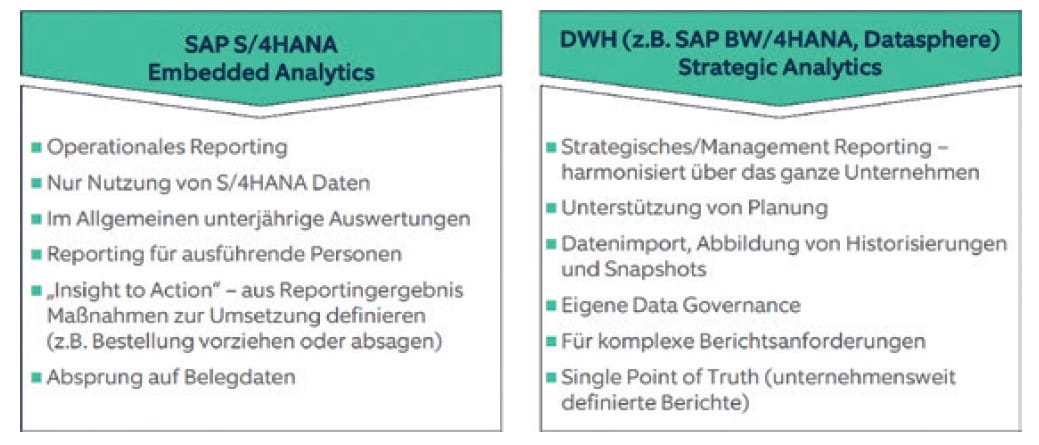Intelligent analytics solutions for challenging times


The Walldorf-based software company SAP has been pursuing the philosophy of the "Intelligent Enterprise" for some time now. The starting point of this idea is that modern technologies enable companies to use data easily and thus make evidence-based decisions. Implementing this reduces the risk of planning errors and uneconomical investments.
Although some companies already have very good approaches to this, many companies still find data-supported, evidence-based management difficult. In many cases, they already lack a solid basis for modern data analysis. Daniel Schoen, analytics expert at Nagarro: "If companies do not recognize the importance of their data pools, they often limit their analyses to isolated area analyses - in the form of reports, for example. Strategic management thus forgoes information that is relevant to decision-making. It's like a captain who forgoes the navigator."
The evolution of data management
Nagarro uses the metaphor of evolution to assess the current status of internal analytics concepts. The company's IT specialists draw a four-stage progression.
This begins with "descriptive analytics". Here, the relevant analysis systems only record the current status quo - for example, which ROIs or cash flows the company is reporting. More in-depth analyses - such as a detailed analysis of the individual components of a KPI - are not provided here.
The second evolutionary step is "diagnostic analytics". Here, companies are already using analytics solutions for initial in-depth evaluations - for example, to investigate the causes of the company's current status, such as a low return on equity or stagnating sales. It is therefore no longer "just" about isolated key figures, but about their past and current development. The systems also usually allow key figures to be broken down into their individual components ("decompensation") in order to obtain additional detailed information.
This is followed by "predictive analytics", in which the analysis models are already capable of making forecasts. KPIs or current developments can therefore not only be analyzed retrospectively, but also extrapolated for the future. This allows companies to forecast future sales, for example, and gain an indication of which markets, regions, offers and services could be particularly lucrative in the future.
The current conclusion is "prescriptive analytics". The analysis tools not only predict future trends, but also proactively advise companies on how to achieve their previously defined goals more quickly. This requires powerful AI tools that can not only extrapolate trends, but also provide the company with specific suggestions for optimization based on the previously defined goals.
Although this four-stage evolutionary process is simplistic and ideal-typical, it nevertheless offers good starting points for evaluating the current status of a company. This classification also allows Nagarro to provide a company-wide overview of the current status. Daniel Schoen comments: "Many companies are currently somewhere between diagnostic and predictive analytics. They often lack systematic approaches for a future-proof, expandable solution. In some cases, there is a proliferation of heterogeneous systems. This results in a confusing, barely manageable shadow IT system. In the face of increasingly fierce international competition, however, modern solution concepts are needed."

Two basic building blocks for intelligent analytics solutions
What these ultimately look like varies from company to company. This depends, for example, on the industry to which the company belongs and its size. Nevertheless, it is possible to outline at least a solid initial concept for most companies: This consists of two building blocks that the company can add further elements to as required.
- Module: Embedded Analytics
For the more operational or decision-supporting functions of the analytics landscape, the concept proposes "embedded analytics". Companies can use it to create reports, monitor ongoing processes in real time and generate initial efficiency reserves from the insights gained in this way - for example, by optimizing the timing of orders with specific upstream suppliers.
The data basis and technical foundation for this is SAP S/4HANA. Enrichment from other data sources is explicitly not planned here - partly to ensure ease of use. This is achieved almost intuitively by using analytical Fiori apps as the front end. To support this, SAP offers a range of predefined Smart Business Fiori apps for KPIs, various drill-down menus and numerous filter functions.
Thanks to its clear structure, embedded analytics is therefore also ideal for less tech-savvy users, for example in individual departments. Daniel Schoen: "A key advantage of the embedded analytics concept is that it is mainly based on the components of SAP S/4HANA - and therefore does not require any significant additional investment. But the concept can also help to standardize heterogeneous solution approaches later on, for example."
- Module: Data warehouse and strategic analytics
As embedded analytics is primarily aimed at operational analyses, it reaches its limits for strategic tasks in particular. This is where companies need complementary concepts. SAP Datasphere or SAP BW/4HANA in combination with the SAP Analytics Cloud, for example, form the technical infrastructure.
The overarching task of the strategic solution is then to define a single point of truth for companies: a uniform data pool in which companies can merge, collect, standardize and consolidate their data and thus prepare it for complex evaluations and planning. Data imports from different sources are also possible in this system.
In contrast to the embedded analytics approach, the strategic solution is aimed at analyses that go well beyond the departmental view - in other words, where the focus is on the company as a whole and its long-term development. Based on this data pool, which can also include historical data, complex predictive and prescriptive analytics processes such as far-reaching forecasts can be implemented, usually supported by modern AI models.
Daniel Schoen summarizes: "The data warehouse approach for strategic tasks and the embedded analytics concept for operational business usually complement each other perfectly. Together, they create a solid analytics foundation. "If required, companies can supplement this with additional solutions - for example with the SAP Integration Suite or the SAP Sustainability Control Tower. For many companies, however, even the basic concept would be a real step forward."
To the partner entry:






